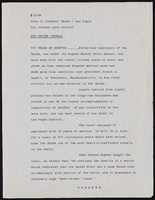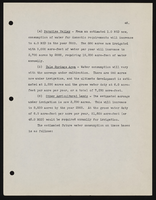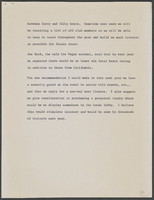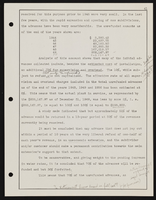Search the Special Collections and Archives Portal
Search Results
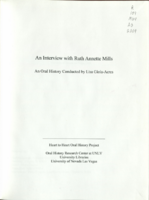
Transcript of interview with Ruth Annette Mills by Lisa Gioia-Acres, November 20, 2008
Date
Archival Collection
Description
Ruth Annette Mills was born and raised in Washington, D.C. She recalls the early years during WWII, her father's cancer and radium treatment under Blue Cross Blue Shield, his passing when she was nineteen, and her marriage that same year. Ruth and her husband and family lived in Georgia, Texas, and Maryland before coming to Las Vegas in 1968. She worked as a typist for the Office of Education at one point and did volunteer work for her church, the Cub Scouts, and the League of Women Voters. She also worked as a clerk-typist for the Clark County School District, and eventually became a teacher through the Teacher Corps program. She graduated in 1975 and was hired to teach 6th grade at CVT Gilbert. The school integration program was just beginning when Ruth was first hired as a teacher. She held the position of facilitator and recalls how angry parents were when they learned their children had to be bussed to sixth grade centers. Having been involved through her church with the Civil Rights Movement in other states, she was disappointed with the racist attitudes she encountered in Las Vegas. Ruth's involvement with health care began when her daughter-in-law developed kidney stones and was denied treatment. In 1993 she started the Nevada Health Care Reform Project through the League of Women Voters in order to support Bill Clinton's health plan. Fifteen years later, over 100 organizations had come on board to support the League's coalition in favor of Clinton's plan, and her fondest wish is that one day Universal Health Care will be available to all Americans.
Text

Photograph of Ramsey Street, Goldfield (Nev.), early 1900s
Archival Collection
Description
Caption: Ramsey St. Goldfield, Nev
Image
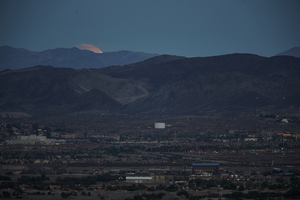
Super-moon rises at sunset while also being in a lunar eclipse September 27, 2015 as seen from the Whitney Mesa in Henderson: digital photographs
Date
Archival Collection
Description
Image

Photograph of Jerry Tarkanian, circa 1992
Date
Archival Collection
Description
Image
Golden Anniversary open house: Circa 1959 Exhibit, 2009
Level of Description
Scope and Contents
Includes event profile, "The Year 1959" handout, display ad in Las Vegas Review Journal.
Archival Collection
Collection Name: Junior League of Las Vegas' Records on the Morelli House Preservation Project
Box/Folder: Box 06
Archival Component

